Who’s helped you in your career?
An instructor, manager or colleague probably spotted your potential at some point and pushed you towards training that propelled you to the next level.
Employee development plans—something today’s workers are asking for more of—give you an opportunity to offer a similar type of support for employees in your organization and boost engagement.
Creating an effective plan, however, can be a confusing experience—especially if it’s your first time.
There’s no shortage of employee development plan examples, tips and techniques suggesting how complex (or concise) your plan should be and how it should integrate with your overall employee development program.
In this post, you’ll learn the simple steps (and examples) needed to create an employee development plan that aligns your organization’s goals with its employees’ career ambitions.
To help you easily create and customize a plan that accounts for your workforce’s current skills, and your firm’s capabilities and resources, you’ll also get three fundamental templates that serve as the building blocks behind every employee development plan.
Table of contents:
What is an employee development plan?
As part of a broader employee development program, an employee development plan provides staff, management and HR with a document detailing an employee’s career goals as they relate to the organization they’re in.
Formed by both the employee and their manager, the plan serves to provide structure and guidance around goals and opportunities within the organization.
An employee development program with effective plans leads to better succession planning, employee retention and overall workplace success. It tactfully balances the employee’s ambitions and the organization’s goals to create mutually beneficial career advancement opportunities.
The benefits of an employee development plan
High employee turnover has been declared a “trillion-dollar” fixable problem for US-based businesses. A significant contributor to this costly problem for any organization is poor career development opportunities for employees.
Focusing solely on skills and proficiencies that employees want to develop, however, doesn’t always translate into an upside for the organization.

Executed correctly, an employee development plan ensures that employees upskill or progress into roles that strengthen the organization by reducing skills gaps and increase employee engagement by satisfying individual career goals.
The end result is a mutually beneficial system for all involved parties that:
-
Helps fix the silo mentality in your organization
-
Improves your workplace’s adaptability
-
Boosts employee retention
-
Connects employee learning and development to performance management
-
Enhances succession planning
-
Creates an employee experience that attracts high-performing talent
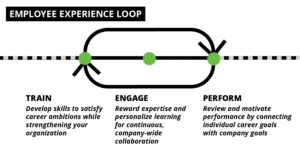
These benefits are pivotal and strengthen your organization’s ability to engage, retain and manage employees.
Employee development plan examples (and templates)
Now that we’ve reviewed the benefits of an employee development plan, here are some specific examples and templates (based on a fictitious scenario) to inspire your next plan.
The scenario:
Yolande, a customer service assistant, has set the goal:
“To become a customer service manager by the end of the year.”
Her manager, Eddie, checks in with Yolande. Acknowledging their company’s rapidly expanding user base and technical products, he agrees that she’d make a valuable customer service manager.
Together they discuss the skills Yolande needs to acquire and the attitude she should display to make her a fit for the role in the future.
Given that employee training governs employee development and critical workplace competencies, we’ll start with a skills-focused plan and then show how it evolves to connect with performance management .
Tip: Choosing to prioritize skills development doesn’t mean you have to neglect actions that employees should take. Feel free to combine any of the employee development plan templates below.
Example #1: Skills-based employee development plan
Yolande’s manager, Eddie, explains that she could do with a few more customer service, management and technical product-specific competencies to lay the foundation for her career goal of becoming a customer service manager.
After explaining how these will help her develop the right expertise, he makes a list of e-learning modules around the following topics that are offered in the company’s learning management system, Totara Learn :
-
Conflict resolution
-
Team management practices and SOPs
-
Technical certifications showing her product-specific proficiencies
Eddie (or other LMS admins) can now create specialized learning plans that link to customer service and management competencies in the company’s performance management system , Totara Perform.
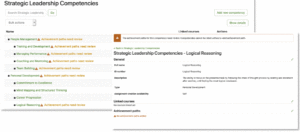
This integration makes employee development programs more effective and easier to manage for Eddie.
He can now connect Yolande’s development to her performance, document frequent check-ins, establish more competencies and suggest additional performance-related training.
Template:
Employee goal: Become a customer service manager
Skills required:
-
Conflict resolution
-
Technical certifications showing her product-specific expertise
-
Team management practices and SOPs
Qualities and abilities to demonstrate:
-
Ability to lead projects and guide team members
-
Make critical decisions and prioritize projects
-
Resolve conflicts and empathize with dissatisfied customers
What employee training activities to include
Typically, an employee development plan will include a learning plan that covers e-learning modules and/or face-to-face seminars as a bare minimum. But think about each individual employee. How do they learn best? What will inspire them or get them thinking differently?
Below are just a few of the learning activities you might consider adding to a learning plan:
-
E-learning modules and digital courses
-
Face-to-face seminars
-
Events or conferences
-
Mentoring/coaching programs
-
Books, journals and magazines
-
Workshops
-
Special projects
Example #2: Performance-based employee development plan
The performance-based plan builds on the foundation of the previous example to help establish key training goals and milestones.
This is because the manager’s role isn’t to dictate how employees should reach their goals. It’s to use their knowledge of a typical progression path—and resources at their disposal—to document employee development and set milestones that are both tailored to an individual’s career growth and beneficial to the organization.
After establishing the fundamental skills-based competencies, it’s time to agree on important milestones and actions that the employee must accomplish in a given period to demonstrate their progress, skills and ability to deliver.
The most effective way to do this is to use concrete goals, such as Objectives and Key Results (OKRs).
Objectives: Are the qualitative, broad and high-level outcomes that are to be achieved. Above all else, setting good objectives is about clarity. You should explicitly state what the objective is and the deadline for it.
Key Results: Quantify objectives and break them down into specific steps/stages that can be used to measure performance and track progress.
Template:
Objective:
Design and launch an onboarding course for new customers
Key Result:
-
Survey 15 customers about their training and support needs
-
Outline the content to be included in the program with the help of other customer support team members
-
Draft 5 training modules
Example #3: The comprehensive employee development plan
The comprehensive 3-year employee development plan (adjust the timeframe as you see fit) combines both of the employee development plan examples mentioned above. Breaking down goals and milestones by specific timeframes, it includes the:
-
Training and development needs of employees
-
Competencies and skills required to progress
-
Milestones to reach or actions steps to accomplish
-
Any resources required that are specific to the development plan
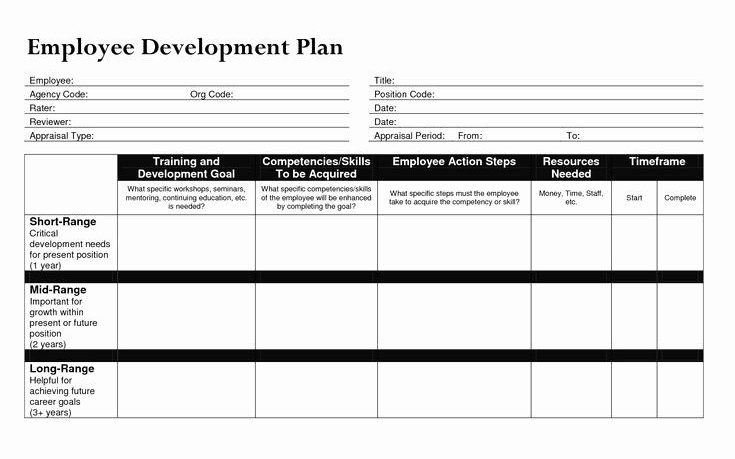
Using employee development programs to support your mission
Creating progression paths that fix organizational skills gaps, assessing specific competencies and fostering an environment that nurtures employee development, is a systematic process that requires the right tools and tactics. Here’s how to get started:
Step 1: Use a skills gap analysis to determine organizational needs
In their Future of Jobs Report , the World Economic Forum stated that by 2022 almost 54% of all workers will need to update or learn new skills thanks to digitalization and the rapid evolution of technology.
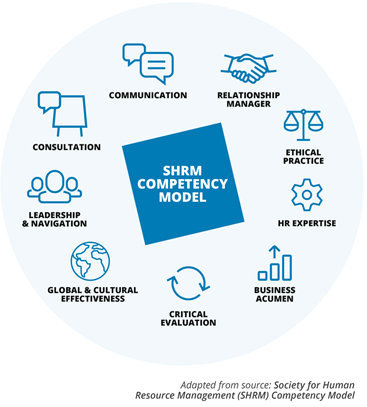
Without the right competencies and skills, your workforce and organization is vulnerable to change and poorly positioned to adapt. That’s why your first step when creating an employee development plan should be to start with a skills gap analysis.
A successful analysis will give you data-driven insight into:
-
Job roles that need to be redesigned
-
Employees that need to be trained, developed and promoted
-
The right skills and experiences you should prioritize when hiring
When designing an employee development program, these insights allow you to work backward from your organization’s overall objectives and long-term mission.
Step 2: Check-in with your employees
With knowledge of where your organization is headed and data-driven insight into the “chinks in your companies armor”, it’s time to align what the company needs with employee goals and aspirations. To do this, ask questions like:
-
Which aspects of your role do you like/dislike the most?
-
Which skills and competencies would you like to improve?
-
Are there any unfilled roles within the organization that you’d like to fill?
Striking this delicate balance means you can advance organizational objectives and improve workforce productivity by giving employees the training they need or are most passionate about.
But what happens if an employee expresses a strong interest in skills that the organization doesn’t need in the short term?
Don’t veto their requests for training. In some cases (particularly if they’re a perfect candidate for a vital role), you should consider arranging an agreement.
Depending on your available resources and needs, this could mean you offer to fund the training they desire on the condition that the employee will in return train for the competency/role the organization needs.
Recommended read: A busy manager’s checklist for perfect employee check-ins
Step 3: Use these tools to connect employee development to performance
An adaptable performance management system
Totara Perform supports both traditional and continuous performance management . As mentioned above, you can build the competency structures your organization needs and link them to learning plans in your LMS.
Managers, for example, can assign a “rating” (such as Beginner, Improving or Expert) to each competency in an employee’s learning plan based on evidence of their competence.
(Evidence includes completed training, noted behaviors in day-to-day roles or certifications and badges from previous roles.)
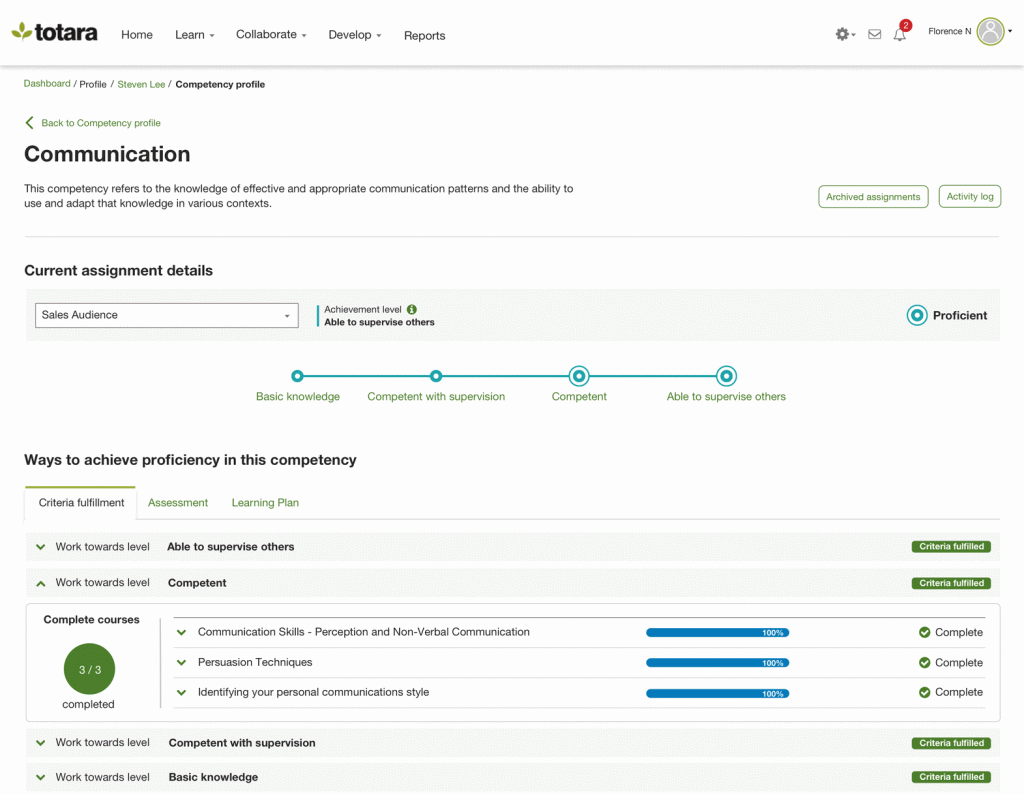
This allows you to connect the dots between employee development and workplace performance. Totara Perform also integrates with your HCM and CRM tools to help you evolve existing processes and workflows without shoehorning you into a specific style of management.
Competencies to monitor and measure development
Having a central system to track employee feedback, set goals and connect learning to performance management simplifies the management of employee development programs.
Using competencies is central to all of the above. These are measurable skills, knowledge or behaviors that employees need to effectively perform in their roles, and are closely linked to employee development programs and plans.
Using a performance management system like Totara Perform, managers can build compliance and competency structures across all divisions and positions within an organization, with competencies being linked to courses, roles and learning plans.
A learning experience platform for peer-to-peer mentorship
A learning experience platform (LXP) is a powerful tool in your employee development program because it can be customized to support employees at every stage of their careers.
Suggested read: LMS vs LXP: Which one do you really need?
From brand-new employees to experienced senior management, an LXP connects people with similar learning needs—whether that’s by role, location, seniority level or skill set.
Not only will this help your people share knowledge, collaborate on projects and communicate with colleagues, but it also opens up the opportunity for developing employees to be mentored by senior experts.
Experts can curate training resources from multiple channels to create personalized development paths, answer questions from mentees and track how engaged mentees are.
This provides employees a dedicated place to develop their skills, discuss ideas with colleagues and solve problems together in an engaging and interconnected way.
Upgrade your employee development program
Totara Perform, our adaptive performance management system, does not force you to adopt a specific approach. The system supports and grows with you, regardless of which end of the “performance management spectrum” you happen to sit on.
It also connects with your existing HCM and CRM tools to help you make the switch without destabilizing existing processes and workflows.
If you’re interested in Totara Perform, book a demo now.
Alternatively, feel free to join the Totara Community where you can learn more about continuous performance management, and experience the features of our LMS, LXP and performance management system.
We’d recommend signing up for our competency framework and evidence-based appraisals courses to get started. (You’ll learn best practices and get to use Totara Perform’s features).
Author bio: Hassan Uddeen is a freelance content strategist and SEO specializing in HR and B2B content marketing






